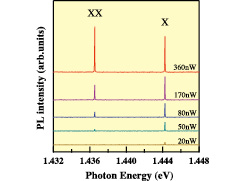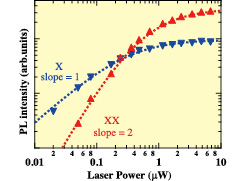Biexciton Luminescence from Individual Isoelectronic Traps in Nitrogen δ-Doped GaAs
K. Takamiya, H. Yaguchi, and H. Akiyama
Single photons and entangled photon pairs are expected to play an important role in the field of quantum information science and technology, such as quantum key distribution and quantum computation. Single isoelectronic traps formed by nitrogen–nitrogen (NN) pairs in GaAs are also promising candidates for generating single photons or entangled photon pairs [1-6]. The present paper reports on the observation of biexciton emission from individual isoelectronic traps in nitrogen δ-doped GaAs [7].

Fig. 1. Excitation-power-dependent micro-PL spectra obtained from an individual isoelectronic trap in nitrogen δ-doped GaAs.

Fig. 2. PL intensity for the X and XX emission lines as a function of laser power.
The sample used in this study was a nitrogen δ-doped GaAs layer grown on a semi-insulating undoped GaAs (110) substrate by low-pressure metalorganic vapor phase epitaxy. We measured micro-photoluminescence (PL) spectra at 4.2 K using a diode-pumped solid-state laser (λ=532nm) as the excitation source to observe the emission from single isoelectronic traps. The spatial and energy resolutions of the micro-PL measurement system used in this study were ~1 μm and ~30 μeV, respectively.
Figure 1 shows the excitation-power-dependent micro-PL spectra obtained from an individual isoelectronic trap in nitrogen δ-doped GaAs. As shown in this figure, sharp emission lines with full width at half maximum of about 30 μeV, which may be restricted by the energy resolution of the measurement system, are seen at 1.444 eV (labeled X) and 1.436eV (labeled XX). The PL line labeled X is assigned to the excitonic emission due to a NN pair named Z2 because its photon energy is 1.444 eV. Figure 2 shows the intensity of the PL labeled X and XX as a function of laser power. The intensity of the excitonic emission labeled X increases linearly with increasing laser power while the PL intensity labeled XX clearly shows a quadratic dependence on the laser power under weak excitation conditions. This shows that the emission labeled XX is due to a radiative transition from a biexciton state to an exciton state.
In conclusion, we have observed biexciton luminescence from single isoelectronic traps formed by NN pairs in nitrogen δ-doped GaAs grown on GaAs(110). The biexciton binding energy was found to be 8 meV and almost always constant. Thus, biexciton emission with a highly reproducible photon energy can be easily obtained from single NN pairs in GaAs as in the case of exciton emission. Both the biexciton and exciton emission lines show random polarization and no fine-structure splitting, which shows promise for the application to polarization-entangled photon pairs.
References
- [1] Y. Endo et al., J. Cryst. Growth 298 73 (2007).
- [2] Y. Endo et al., Physica E 40, 2110 (2008).
- [3] T. Fukushima et al., Physica E 42, 2529 (2010).
- [4] H. Yaguchi, Proc. SPIE 7945, 79452F (2011).
- [5] K. Takamiya et al., Mater. Sci. Forum 706, 2916 (2012).
- [6] M. Ikezawa et al., Appl. Phys. Lett. 100, 042106 (2012).
- [7] K. Takamiya et al., Appl. Phys. Express 5, 111201 (2012).
